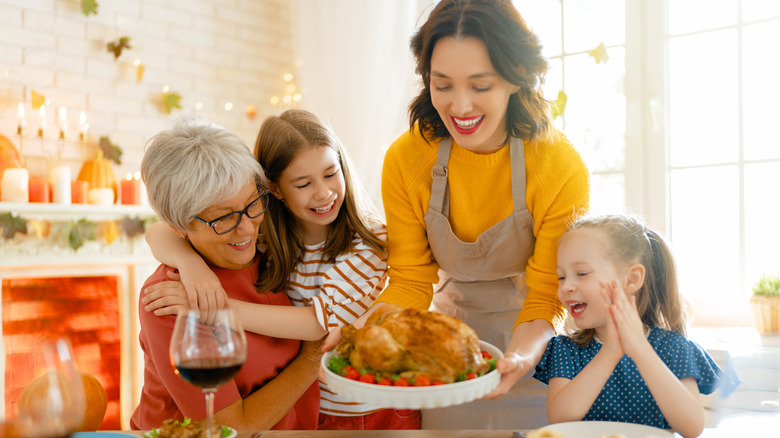Why Evolution Might Be Responsible For Thanksgiving Feasting
Have you ever wondered why, exactly, you're able to pack in so much food on Thanksgiving, when eating that much on a normal day might leave you feeling queasy? A recent study shows that it's probably not just because Aunt Barb's mashed potatoes are irresistible. New research from Britain is highlighting how our eating behavior changes when we have company, and the information explains a lot about why you and your loved ones might eat until you feel too full every year on Thanksgiving.
The study, which came out of the University of Birmingham and published by the American Journal of Clinical Nutrition, analyzed 42 other studies about the social aspects of eating to try to determine if, and why, humans tend to consume more food when dining together (via The Washington Post). It turns out there might be an evolutionary reason why we eat more in groups, and it has to do with our ancient eating, hunting, and gathering behaviors.
We eat more food when we're together
According to Helen K. Ruddock, one of the authors of the study, humans have eaten more when in groups since hunter-gatherer times (via The Washington Post). That's because resources like food were harder to come by, so there was pressure to eat your fill without taking away from others in the group. This led to most humans adopting the social protocol of eating roughly the same amount of food as others in the group.
At Thanksgiving, if one person is indulging, it makes it easier for others to load up their plates with a second or third helping. And it's not just humans. Other species including chickens, rats, and gerbils all seem to eat more when they're in a group, too. The authors of the study say that "this suggests it serves an ultimate purpose," perhaps because it encourages those in the group to eat more nutrient-dense protein and fat-filled foods, something that was important in times when food resources for most humans were more scarce. But in humans, how much you eat in a group also depends on who else is in the group with you.
You eat more food when you're with people you love
The study found that if you're eating in a group of mere acquaintances or strangers (like at a work meeting, or at a communal table at a fast-casual restaurant), you're not likely to increase the quantity of food you're eating. In humans, the meal size increases based on how close you are with the other diners. At holidays like Thanksgiving, when you're gathering with your closest loved ones to share a feast, you might end up eating 29% to 48% more food than you would alone or with strangers (via The Washington Post).
When you combine the celebratory aspects of Thanksgiving feasting with the evolutionary impulse to consume more when you're with your loved ones, along with the subtle or not-so-subtle pressure from relatives to clean your plate and enjoy multiple helpings, it can lead to a big increase in how much you eat in one sitting. There was even one study that showed that indulging in sweet foods that are high in fat, like pumpkin pie, is especially associated with group dining.
That means that this year, if anyone at the table tries to give you a hard time about going back for seconds of your favorite Thanksgiving side dishes, you can just tell them it's your evolutionary destiny.


